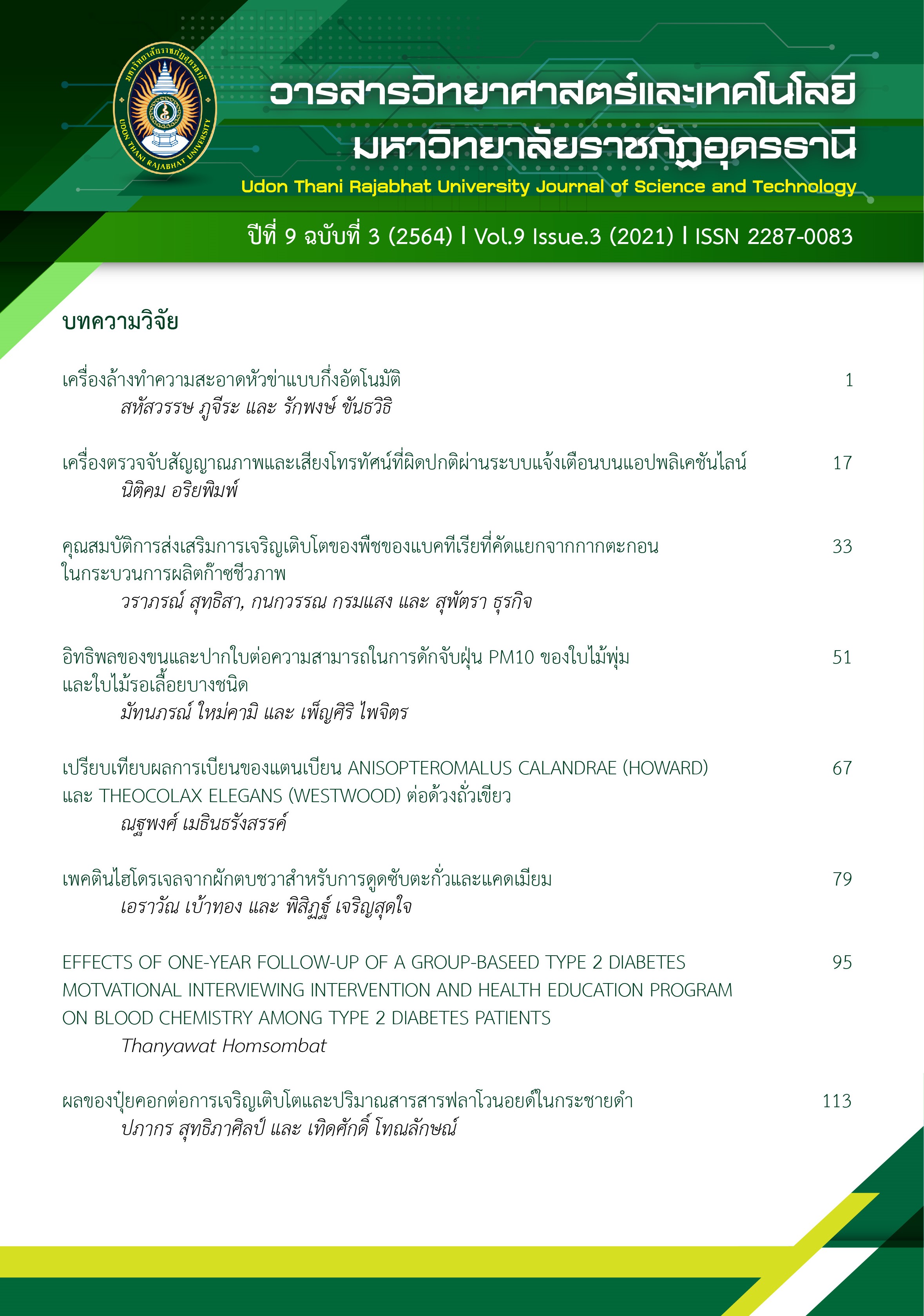คุณสมบัติการส่งเสริมการเจริญเติบโตของพืชของแบคทีเรียที่คัดแยก จากกากตะกอนในกระบวนการผลิตก๊าซชีวภาพ
Main Article Content
บทคัดย่อ
งานศึกษานี้มีวัตถุประสงค์เพื่อคัดแยกหาเชื้อแบคทีเรียจากกากตะกอนก๊าซชีวภาพและทดสอบคุณสมบัติในการส่งเสริมการเจริญเติบโตของพืช โดยแยกเชื้อแบคทีเรียได้
ทั้งหมด 77 ไอโซเลต เป็นแบคทีเรียแกรมบวก 56 ไอโซเลต แบคทีเรียแกรมลบ 21 ไอโซเลต การทดสอบคุณสมบัติการเป็นแบคทีเรียส่งเสริมการเจริญเติบโตของพืช ประกอบด้วย
การทดสอบการตรึงไนโตรเจน การสร้างสารไซเดอโรฟอร์ การละลายฟอสเฟต และการสร้างกรดอินโดล-3-แอซีติก จากผลการทดลองพบว่าการทดสอบความสามารถในการตรึงไนโตรเจนบนอาหาร nitrogen free solid malate Medium (NFM) มีแบคทีเรียทั้งหมด 52 ไอโซเลต ที่สามารถตรึงไนโตรเจนจากอากาศได้ โดยแบ่งเป็น 2 กลุ่ม คือ กลุ่มที่เจริญบนอาหาร NFM ได้และสามารถเปลี่ยนสี bromothymol blue 27 ไอโซเลต และกลุ่มที่เจริญบนอาหาร NFM ได้ แต่ไม่สามารถเปลี่ยนสี bromothymol blue 25 ไอโซเลต การทดสอบการสร้างสารประกอบไซเดอโรฟอร์ บนอาหาร Chrom Azurol S (CAS) พบแบคทีเรียที่สามารถสร้างสารประกอบไซเดอโรฟอร์ได้ทั้งหมด 70 ไอโซเลต การทดสอบความสามารถละลายฟอสเฟตบนอาหาร GYA double-layered agar medium พบว่ามี 24 ไอโซเลต ที่เจริญและสร้างบริเวณใสสีน้ำเงินรอบๆ โคโลนีได้ และการทดสอบความสามารถในการผลิตกรดอินโดล-3-แอซีติก พบว่ามี 67 ไอโซเลต ที่สามารถผลิตกรดอินโดล-3-แอซิติกได้
Article Details
เอกสารอ้างอิง
ณิชชา บูรณสิงห์. (2563). ก๊าซชีวภาพผลผลิตจากมูลสัตว์สู่พลังงานทดแทน. สืบค้นเมื่อวันที่ 29 กันยายน2563 จาก https://www.parliament.go.th/ewtadmin/ewt/ parliament_parcy/ewt_dl_link.php?nid=66535&filename=thai_national _assembly
วราภรณ์ สุทธิสา และ บุษบา วาปี. (2562). การคัดแยกแบคทีเรียส่งเสริมการเจริญเติบโตของข้าวจากดินบริเวณรอบรากต้นบานไม่รู้โรยป่า (Gomphrena celosioides Mart.). วารสารวิทยาศาสตร์และเทคโนโลยี มหาวิทยาลัยอุบลราชธานี, 21(3), 87-94.
ศูนย์บริการข้อมูลโครงการศึกษาวิจัยต้นแบบวิสาหกิจชุมชนพลังงานสีเขียวจากพืชพลังงาน. (2556). คู่มือการลงทุนโรงไฟฟ้าก๊าซชีวภาพจากพืชพลังงาน. กรุงเทพฯ: หจก.มิตรภาพการพิมพ์.
Ahmad, F., Ahmad, I., & Khan, M.S. (2005). Indole acetic acid production by the indigenous isolates of azotobacter and fluorescent pseudomonas in the presence and absence of tryptophan, Turkish Journal of Biology, 29, 29-34.
Bakthavatchalu, S., & Shivakumar S. (2016). Siderophore production by Pseudomonas aeruginosa FP6, a biocontrol strain for Rhizoctonia solani and Colletotrichum gloeosporioides causing diseases in chilli. Agriculture and Natural Resources, 50(4), 250-256.
Bharucha, A. E., Permberton, J. H., & Locke, J. R. (2013) American gastroenterological association technical review on constipation. Gastroenterology, 114(1), 218-238.
Chandna, P., Nain, L., Singh, S., & Kuhad, R. C. (2013). Assessment of bacterial diversity during composting of agricultural byproducts. BMC Microbiology, 13, 1-14.
Glickmann, E., & Dessaux, Y. (1995). A critical examination of the specificity of the Salkowski reagent for indolic compounds Produced by phytopathogenic bacteria. Applied and Environmental Microbiology, 61(2), 93–796.
Goswami, D., Pithwa, S., Dhandhukia, P., & Thakke, J. N. (2014). Delineating Kocuria turfanensis 2M4 as a credible PGPR: a novel IAA producing bacteria isolated from saline desert. Journal of Plant Interactions, 9(1), 566–576.
Gupta, S., Meena, M. K., & Datta, S. (2014). Isolation, characterization of plant growth promoting bacteria from the plant Chlorophytum borivilianum and in-vitro screening for activity of nitrogen fixation, phospthate solubilization and IAA production. International Journal of Current Microbiology and Applied Sciences, 3(7), 1082-1090.
Hafeez, F. Y., Yasmin, S., Ariani, D., Rahman, M., Zafar, Y., & Malik, K. A. (2006). Plant growth-promoting bacteria as biofertilizer. Agronomy for Sustainable Development, 26, 143–150.
Hameeda, B., Harini, G., Rupela, O. P., Wani, S. P., & Reddy, G. (2008). Growth promotion of maize by phosphate solubilizing bacteria isolated from composts and macrofauna, Microbiology Research, 163, 234—242.
Hendroko, R., Wahyudi, A., Situmorang, E. C., Toruan, N., Liwang, T., & Wahono, S. K. (2012). Bacteria biodiversity in cow dung, capsule husk and seed cake of Jatropha curcas Linn anaerobic digesters. International Biology Conference (IBOC), Surabaya.
Kanimozhi, K., & Panneerselvam, A. (2010). Studies on isolation and nitrogen fixation ability of Azospirillum spp. isolated from Thanjavur district. Pelagia Research Library, 1(3), 138-145.
Kesaulya, H., Baharuddin, Zakaria, B., & Syaifu, A. S. (2015). Isolation and physiological characterization of PGPR from potato plant rhizosphere in medium land of Buru island. Procedia Food Science, 3, 190–199.
Pahari, A., & Mishra, B. B. (2017). Characterization of siderophore producing rhizobacteria and its effect on growth performance of different vegetables. International Journal of Current Microbiology and Applied Sciences, 6(5), 1398-1405.
Rana, A., Saharan, B., Joshi, M., Prasanna, R., Kumar. K., & Nain, L. (2011). Identification of multi-trait PGPR isolates and evaluating their potential as inoculants for wheat. Annals of Microbiology, 61, 893-900.
Sutthisa, S., & Khamjandee, S. (2019). Isolation and selection of plant growth promoting rhizobacteria from Wedelia trilobata (L.) A.S. Hitchcock rhizosphere. RMUTP Research Journal Science & Technology, 13(2), 9-92.
Vishan, I., Sivaprakasam, S., & Kalamdhad, A. (2017). Isolation and identification of bacteria from rotary drum compost of water hyacinth. International Journal Recycling Organic Waste in Agriculture, 6, 245–253.
Zhang, J., Wang, P., Fang, L., Zhang, Q. A., Yan, C., & Chen, J. (2017). Isolation and characterization of phosphate-solubilizing bacteria from mushroom residues and their effect on tomato plant growth promotion. Polish Journal of Microbiology, 66(1), 57–65.


